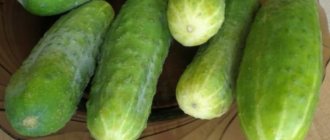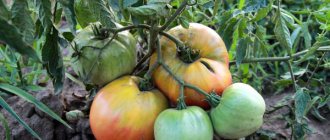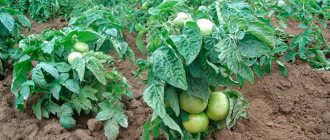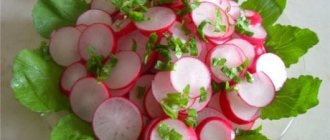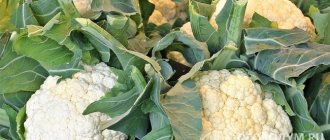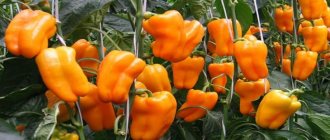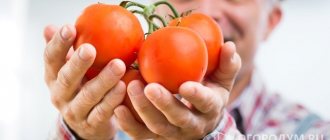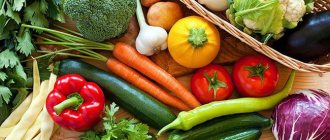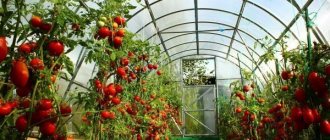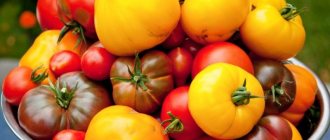Tomatoes can now be bought in any supermarket and at any time of the year. But it’s not at all clear what they are “stuffed with.” And growing your own harvest and making your family happy, knowing that there is nothing unnecessary or harmful in vegetables, is, of course, great. But a person who wants to plant tomatoes in his greenhouse always faces a choice: which seeds to buy in order to get the desired quality and a good harvest. Many gardeners have long decided that it is better to sow tomato hybrids in greenhouses. We will look at why this is so in this article.
Rating of tomato varieties and hybrids
It is difficult to figure out which varieties are really good, because more than 7 thousand types of pure varieties and hybrids are known.
In order not to make mistakes when choosing seeds, you must initially know in what conditions the plants will be located, on what soil, as well as the required time frame for ripening vegetables.
Also determining factors will be:
- form;
- color;
- taste characteristics.
Some gardeners choose varieties that are grown year after year, whose taste qualities and growth conditions suit them, and do not want to change anything. Other gardeners prefer to experiment, and therefore try to grow new breeding products to find the ideal tomatoes and hybrids.
Differences between hybrid and varietal tomatoes
When purchasing seeds of a variety you like, an experienced gardener analyzes its characteristics at the end of the season: early maturity, yield, taste, color, care features. If everything is satisfactory, he selects high-quality, ripened fruits and releases seeds from them.
Next year there is no need to go to the store. You can use your own seeds. All varietal qualities are preserved. With F1 everything is different. You will have to buy seeds annually; getting yours from a hybrid form does not make sense. The second generation may unpleasantly surprise:
- the bushes will be of different heights;
- fruits differ in color, shape, size;
- productivity is low.
The best F1 tomato hybrids
Hybrid plants are in demand among gardeners for the following reasons:
- Resistance to diseases and viruses;
- Good adaptation to growing conditions;
- Reliable ovary;
- Smooth fruits;
- Stable yield.
Breeders are trying to create hybrids that would have excellent taste, are not afraid of temperature changes or extreme heat, and have good resistance to bacteria.
Of the hybrid tomatoes, it is worth highlighting the following five best F1 varieties:
- Incas. This is the brainchild of Dutch breeders, registered in the Russian register in 2000. Mid-early hybrid. He reaches a meter in height. Vegetables are pepper-shaped, with fleshy pulp, red. Advantages of the hybrid: resistant to diseases; not afraid of sunburn; gives a good harvest; The fruits are storable and suitable for long-term transportation.
- Torquay. Another “Dutch” who took root in the Russian garden and was registered in the Russian register in 2007. This is a variety of medium ripeness; approximately 119 days pass until ripening. The bush grows up to a meter, determinate, with multiple trusses. Each vegetable weighs approximately 100 g and has an elongated shape. The hybrid is great for canning. Advantages: good heat resistance, resistance to bacteria and fungi.
- Mariana. The hybrid appeared thanks to the efforts of French-Japanese breeders. The color is red, the shape is elongated, oval, the flesh is dense. This hybrid is suitable for growing in small greenhouses and is not afraid of high temperatures. The tomatoes are very tasty with just a touch of sweetening.
- Bagheera. French creation. Features: cold weather resistance and drought tolerance. The bushes do not need tying. The hybrid is not affected by infections. Bagheera – medium early.
- Semko 2005. Bushes are grown in open ground, but can also be located in a greenhouse. The shape is pepper-shaped, the flesh is dense. The bushes are medium-sized. Features: resistance to heat, drought, disease.
All these hybrids have good taste and are not susceptible to disease.
Features of choosing hybrid seeds
A hybrid is obtained by crossing two varieties that have some desired qualities. For example, one variety is characterized by high yields, but cannot resist diseases. The other has immunity against diseases, but the number of tomatoes harvested per season is much less. The hybrid has a number of advantages:
- the seeds sprout together;
- less demanding on growing conditions;
- more resistant to diseases;
- has improved taste compared to pre-hybridization;
- The yield is much higher, the fruits are even.
The second generation hybrid will not give the same results as in the first year of cultivation. Therefore, seeds will have to be purchased every year.
Before choosing the desired variety of tomatoes, you need to know their main characteristics. And also remember that it is better to grow varieties and hybrids acclimatized in a given area. Therefore, plants created by Russian breeders are suitable.
Productivity obtained by selection
It may not be strange, but the yield of tomatoes in a greenhouse depends on weather conditions. The more sunny days, the faster the fruits ripen. And also from good agricultural technology. With the right approach and good weather conditions, you can collect up to 10 kg of fruit from one bush, and half as much in open ground. But each variety has its own yield. So the hybrid Sumochka is about 16 kg per square meter, and Evpatoriya is up to 40 kg. Russian size – 10 kg. You can increase productivity in the following simple ways:
- From each cluster of determinate varieties you need to cut several green fruits. Then the remaining fruits will be larger;
- You can place buckets of manure around the perimeter of the greenhouse. The concentration of carbon dioxide increases, and tomatoes grow faster.
Productivity cannot be increased by uncontrolled application of mineral fertilizers.
Bush type
Determinant. Or limited in growth. The growth of the central stem ends with a flower cluster and the movement of the strongest lateral shoot begins. These are hybrids such as Volgograd, Cavalcade and others.
Indeterminate. Not limited in growth. That is, you will have to pinch the top of the bush at the desired height. Example: Krasnobay, Gilgal, Ural, Typhoon F1.
Main types of bushes
Depending on the power of the plant, it is formed from one to three stems.
Tomato ripening speed
Greenhouse tomatoes are divided into early, medium and late ripening. The days from planting seedlings to harvesting the first harvest are taken into account:
- early ripening (90 - 95 days). Cavalcade, Evpatorius, Agatha, Aphrodite;
- mid-season (100 – 110 days). Krasnobay, Sibiryak, Miracle of the Earth;
- late ripening (from 115 days). Ural, Volgograd, Russian size, Snowfall;
Volgogradsky is mid-season and bears fruit after 110 days
Disease resistance
Hybrid plants resist diseases better than varietal tomatoes. Resistant to fusarium, cladosporiosis, tobacco mosaic.
Manifestation of cladosporiosis of leaves
You cannot rely on this feature of hybrid tomatoes. Disease prevention measures will protect against crop loss.
Storage duration
Late-ripening varieties are stored for a long time. Gardeners collect them at the stage of milk maturity. The fruits lie for some time in a dark place and at room temperature (7-20 degrees), ripening to the desired condition. But these tomatoes have a peculiarity - they have rough skin and the taste is slightly lost. Typically, the raceme varieties are stored better. Until the New Year, the fruits of the hybrids Long Keeper, Sochelnik, Zazimok, and Red Stone may lie.
The best varietal tomatoes
Among the varietal species obtained as a result of selection by breeders, it is worth mentioning the five best:
- "Crimson Giant" Weight can reach up to 800 g.
- "Steak". Weight - up to 500 g. Tomatoes are thin-skinned, but do not burst when they reach maturity.
- "Sugar Bison" Gardeners praise the good yield: vegetables weighing up to 600 g. The pulp is fleshy and dense.
- "Mikado." The tomatoes weigh about 400 g, are very tender and tasty. Pink colour. “Mikado” is recommended to be consumed in the form of salads.
- "Black Prince". Weight is about 200 g, but the taste is excellent. “Prince” has an original taste with a characteristic tomato sourness. The pulp is without seeds, very tender.
This is a real decoration for the dining table.
New tomatoes from Siberian Garden
This company is considered one of the best in providing high-quality seeds from which strong and healthy tomato bushes grow, intended for difficult climatic conditions. New varieties include:
- "Shuttle". Low, even stunted type, up to 60 cm high, early ripening. The vegetables are bright red and plum-shaped. Usually the brush grows up to 6-8 pieces.
- "Alpatieva". Also an early ripening tomato. Not tall, rises up to 50 cm. The weight of one fruit is 70 g, and there are 7 of them in the hand. The plant is unpretentious.
- "Hospitable." Mid-season. The tomatoes are large, weight up to 500 g. Plant height – up to a meter. The variety is capricious and requires increased lighting and additional fertilizing.
- "Bullfinches." The plant grows up to 50 cm in height and is quite resistant to diseases that usually affect traditional varieties. The fruit of "Bullfinches" weighs approximately 130 g. The taste of tomatoes is pleasant, without sourness.
- "Heavyweight." The plant is low, early ripening. Vegetables weighing up to 500 g are very tasty. However, this variety is not suitable for canning, but is excellent for fresh salads.
Many gardeners have already tried the new products from the Siberian Garden and were satisfied. But they note that new tomatoes require additional fertilizing, without which a good harvest cannot be obtained.
Yield tomatoes for greenhouse cultivation
You can remove up to 5-10 kg from one bush if you choose a variety with high yield.
The most productive are recognized:
- "Pink raisins" Weight 60 g, yield – up to 6 kg per bush.
- "Miracle of the Earth." Vegetables weigh 200 g; up to 5 kg can be removed from a bush.
- "Hurricane". Weight is approximately 50 g, yield is up to 5 kg per bush.
- "Kostroma F1". High yield - 11 kg per bush. Weight 150 g.
- "Octopus F1". The average fruit weighs 150 g, and the yield per square meter. m – 16 kg.
- "Tatiana". Weight is 600 g, and up to 9 kg can be removed from the bush.
To increase yield, plants require mineral and organic fertilizing.
Review of the best varieties of tomatoes for 2018-2019
Below we will look at popular varieties of tomatoes for open ground according to their purpose and various characteristics.
The best varieties according to gardener reviews
An important criterion for a reliable variety is stable yield from year to year, the ability to adapt to different regions and weather conditions. Such plants invariably delight their owners.
Fighter (Brawler)
This popular patented variety of Siberian selection is a champion in unpretentiousness. The seedlings do not stretch; they begin to produce buds after the 6th or 7th leaf. The bushes do not suffer from the tobacco mosaic virus, they grow up to 45 cm. Garter and pinching are kept to a minimum (you can do without them).
Ripe cylindrical fruits are ready for harvest 3 months after germination, weight in the lower cluster is 180 g, then 70-90 g each. The yield is up to 5 kg per square meter. The purpose is universal.
Seed packaging
Photo: Olga-70-KAZ
Photo: gggalina
Big Mama
Early ripening (85 days) new product from. The bush is medium spreading, of moderate height. The tomatoes are heart-shaped, quite large (200-250 g) and fleshy for such an early date.
Pink Stella
A mid-early variety from Siberian breeders, consistently producing 6-10 kg per square meter. The internodes are close together, the total height of the bush is about half a meter. Compact in seedlings.
The first fruits are elongated, heart-shaped, up to 300 g, the subsequent ones are cylindrical, 120-200 g each. The color is pinkish-raspberry, the consistency is fleshy, there are few seeds.
Pink Stella
Package
Photo by: Sweet
Tanya F1
Dutch hybrid with high productivity and disease resistance. The bushes are powerful, but compact, approximately 0.7 m high. The tomatoes are spherical, even, 150-200 g. They are dense, but not too hard. Lightweight, do not wrinkle during transportation. The ripening period is mid-early.
Sheriff F1
The hybrid is a new product of Pridnestrovian selection. Combines very early ripening (from 89 days) with a solid weight of round, strong fruits (up to 250 g). Fruiting is long lasting. The brushes begin to be laid above the 5th sheet, then go through the sheet.
The bush is semi-determinate, tall (up to one and a half meters), resistant to viruses and Alternaria spot. Productivity up to 20 kg per square meter.
Early (early ripening) varieties
Early varieties of tomatoes do not have time to gain fleshy pulp, but they are so long-awaited that they seem the sweetest. Able to ripen on the vine even in northern regions.
They are often characterized as resistant to late blight, but this is not entirely true: they simply manage to give up most of the harvest before the infectious attack.
Betta
A tomato with a unique precocity: it turns red after 78-85 days from the beginning of the growing season. In seedlings it does not stretch, it blooms early; requires disembarkation at a permanent place at the age of 1 month. It produces crops quickly, so it doesn’t get sick; frees up the bed for replanting.
The bush is standard, compact, less than half a meter. Suitable for dense placement. Tomatoes are spherical-flattened, 50-70 g in size; harvest from a bush - 1.5-2 kg.
Katya F1
Ultra-early (75 days) proprietary hybrid from with friendly performance in any conditions. Determinant. The brushes begin to appear already above the 5th leaf and bear up to 8 ovaries. Fruit weight is from 80 to 130 g.
Highly resistant to cracking and disease. Productivity is more than 10 kg per square area.
Polfast F1
Hybrid tomato from Dutch breeders with the first harvest 86 days after germination. For such early dates, the fruits are surprisingly dense, of good taste, weighing up to 150 g. The bushes rise 0.6 m and resist disease and cold weather well.
Ultra early ripening
Ripening time is from 80 days, bush height is 40 cm, weight of scarlet round fruit is up to 100 g. No pinching is required. A non-seedling method of cultivation is possible.
Jurand F1
New selection from Transnistria. Disease-resistant, very early (from 80 days) hybrid with long-lasting and high total output - up to 16 kg per square meter. Determinate bushes, up to 0.8 m. Fruit formation begins after the growth of 5 leaves.
The tomatoes are spherical, transportable, weighing 90 g.
Ultra early ripening
Polfast F1
Betta
Jurand F1
Katyusha
short
Small tomatoes (25-45 cm) require minimal care. Standard varieties with thick stems don’t even need to be tied up.
Low-growing varieties of tomatoes for open ground do not require mandatory pinching.
Grigorashik F1
Dwarf superdeterminate hybrid for indoor, potted and decorative culture. The sheet is beautiful, corrugated. Tomatoes weigh 30 g each. The stem length is no more than a quarter of a meter. Can be used in soil and greenhouses as a compactor.
Otradny
A standard bush with a height of 35 cm successfully resists cold snaps and temperature stress. Begins to ripen 3 months after germination. Round tomatoes weigh about 60 g. The plants branch weakly and do not need shaping.
Superclub
A brand new product from the Siberian Garden. Fruiting dates are mid-early. Tomatoes are hidden by thick foliage, they are pink, up to 250 g in size, and ripen on the vine. The stem is standard type, no higher than 40 cm.
Turbojet
New Siberian tomato, very early in date. Cold-resistant and unpretentious. A 40-centimeter bush yields up to two kilograms of tomatoes weighing 60-80 g. You don’t have to pluck or tie them up.
Shuttle
An early ripening (from 82 days) pickling variety with a standard bush no higher than 0.45 m. The fruits are oval-elongated, with a “spout”, strong, beautiful, weighing 30-60 g.
Shuttle
Grigorashik F1 Otradny Superklusha
Turbojet
Tall
Tall ground tomatoes are classified as semi-determinate or indeterminate. Semi-determinants, as a rule, stop growing on their own, having formed the optimal number of tassels. Indeterminates must be stopped in a timely manner - by topping (pinching off the growing points of the main stems) at the end of the season.
Regular stepsoning is a mandatory procedure.
Mirsini F1
Semi-determinate (1.3 meters) early hybrid of Dutch selection with excellent disease resistance and high yield. The tomatoes are round-flat, very strong, large - up to 400 g.
Novosibirsk pink
A new early ripening variety with a stable ovary. Plants are medium-sized, compact. The tomatoes are cube-shaped and elongated, weighing 100 g, pickling type, attractive pink hue.
Normandy
Thanks to its tall bush (150 cm), this tomato successfully combines early harvesting of the first fruits (90 days) with long-term yield and high yield - up to 10 kg per square meter. The weight of one tomato is approximately 160 g; The pulp is tender, suitable for salad.
Seven
A mid-season variety, yielding up to 6 kg per bush, resistant to diseases. Indeterminate plants require reliable staking. Spherical tomatoes weighing 150 g have excellent taste.
High Color 312 F1
Powerful semi-determinant up to one and a half meters high. The initiation of the first ovary is very early - above the 5th leaf. The returns are long-lasting and the overall yield is high. The fruits are extremely dense, pickling type, have the shape of a plum, weight 70 g. Imported from Holland.
High Color 312 F1
Mirsini F1
Novosibirsk pink
Normandy
Seven
Disease resistant
High resistance to diseases is laid down at the genetic level. A guaranteed, obvious effect appears in hybrids.
Other varieties (especially mid-season ones) are more dependent on agricultural technology and weather conditions in terms of health.
Caspar F1
The newest hybrid of English selection. Early ripening (from 85 days), powerful, determinant. Each cluster contains up to a dozen fruits weighing 200 g - smooth, raspberry-pink.
Diabolik F1
Mid-season hybrid from Japan. Determinate, pickling. Tomatoes are elongated, pepper-shaped, strong, weighing 150 g.
Cameo
Ultra-early ripening (89 days), productive tomato of Russian selection. Tolerant to stress, cold snaps, diseases (even late blight). The bush grows no higher than half a meter and does not require pinching. The fruits are one hundred grams, even, smooth; keep up together.
Magnus F1
Cold-resistant Dutch hybrid with abundant ovary. Successfully resists nematodes, viruses and fungal diseases (even late blight). The bushes grow to an average height, the tomatoes weigh 150 g.
Fitous
Medium early, compact, low (0.5 m) variety. Step-sonning is not necessary. Produces a harvest (about 11 kg per square meter) in the mid-early period. Tomatoes are oval-pear-shaped, 50-70 g, universal purpose.
Diabolik F1 Cameo
Fitous
Caspar F1
Magnus F1
The sweetest
Sugary non-hybrid tomatoes are considered the most delicious. The sweetish taste of tomatoes consists of several indicators: the amount of sun and moisture, nutrition, genetic predisposition to the predominance of sugars over acids.
There are truly sweet varieties.
Djalo Santa
Mid-season, medium-growing (0.7 m) variety, tolerant of cool weather and dry soil. The tomatoes are honey-yellow, fruity-sweet, weighing about 150 g. Output per square meter is up to 8 kg.
Pink honey
The popular heart-shaped Siberian tomato, with a record weight of over a kilogram, is meaty and aromatic. The bush grows 0.7 m and needs good feeding and shaping.
Russian delicious
Branded mid-early tomato with dessert fruits up to 300 g in size. Resistant to diseases. The bush is of moderate height (0.8 m), bears up to 4.5 kg. Step-sonning is mandatory.
Super sweet miracle
Medium ripening variety from “Ural Summer Resident”, weighs 150-200 g, sugary. Plant height is 0.7 m. You don’t have to plant stepsons. Disease resistance is high.
Southern tan
Pepper-shaped orange tomatoes weigh up to 350 g and taste like ripe apricots. Keeping quality is long lasting. The bushes are indeterminate, with good ovary even in open ground conditions - it is not for nothing that this is a Siberian selection.
Ripening time is average, yield per plant is up to 8 kg.
Russian delicious Supersweet miracle
Southern tan
Djalo Santa
Pink honey
Cherry
Most cherry tomatoes are characterized by early or mid-early ripening of the first fruits. Even tall cherry tomatoes can be grown in open ground (with the necessary supports). However, there are also special options with restrained growth.
Children's sweet "cream"
On a low bush (0.5 m), oval tomatoes weighing 30 g, deep red in color, quickly set and ripen. There are up to 10 pieces in a brush.
Pearl yellow
Standard determinant up to 30 cm high - a patented “baby” from. Ultra-early (85 days), shade-tolerant. Honey-yellow cherries weigh 20 g.
Sweet meeting
“Vkusnoteka” series from . The bush is medium-sized and needs staking. The tomatoes are deep pink, weighing up to 20 g, in beautiful clusters.
Sweet kiss
Plants reach a height of 80 cm. The tomatoes are red, sugary, up to 20 g in size. Siberian selection.
Unicum F1
Original cherry hybrid from agro. Tomatoes are cylindrical in shape and weigh up to 30 g; color dark red. The bushes are low, standard, disease-resistant. Ripening period is ultra-early (from 80 days). Return per square meter is more than 7 kg.
yellow pearl
Unicum F1
Children's sweet "cream"
Sweet meeting
Sweet kiss
The best tomatoes for growing outdoors
Vegetables that are intended to be grown in open ground should not be afraid of the wind, and also be unpretentious. Among the best are the following varieties:
- "Oak tree." The plant is low-growing, early ripening. “Oak” can also be grown in a greenhouse, but it also does well in open ground.
- "Watercolor". An unpretentious plant that thrives in the climatic conditions of the Urals and the middle zone. Weight – 50 g, bush height – 50 cm. “Watercolor” is suitable for canning.
- "Konigsberg is golden." The bushes grow up to 70 cm. The plant is not afraid of temperature changes and bad weather. Shape – elongated, color – orange. The main advantage is good keeping quality.
- "Supermodel" Variety from the breeders of the Siberian Garden. The plant is characterized by high productivity. Shade-tolerant, relatively unpretentious. The vegetables are elongated, reaching up to 15 cm in length. The flesh is pinkish-red. The taste is sweet.
- "Honey saved." Mid-season plant. Tall. Up to 7 fruits are formed on the cluster, each weighing up to 300 g. Color – yellow, honey. The pulp is tasty.
These bushes can also be grown in greenhouses.
The most popular tomatoes
Among gardeners, the most popular are tomatoes, which produce a good harvest and are disease-resistant.
Tall
Among the tall varieties, the following should be noted:
- “Mom’s Love” The plant reaches 1.5 m and there are up to 20 fruits on the stem. The weight of one is 500 g. The pulp is dense and fleshy. The color is red.
- "Eagle Club". Designed for cultivation in Siberia. Grows mainly in open ground. Early ripening. Pink colour. Bushes are not afraid of weather changes.
- "Pudovik." Siberian variety. The fruits are large, up to 800 g, and shaped like a heart. The pulp is dense, there are almost no seeds.
- "Altai yellow". The main advantage is that the plant does not get sick and adapts well to climatic conditions. The bush grows up to 2 m, and the fruits weigh up to 600 g. They taste sweetish.
- "Heart of a Buffalo" A gift for gardeners from Spanish breeders. The fruits are large, up to 600 g, pear-shaped. Sweet, meaty. Excellent for fresh salads.
Since the bushes grow tall, they are mainly planted in open ground, although they also develop well in greenhouses with a high roof.
Medium height
These species are usually grown in greenhouses. The plants are resistant to diseases and produce a good harvest. The best varieties, according to gardeners:
- "Blagovest F1". The bushes grow up to 180 cm in height, the fruits are round in shape, weighing 100 g. Well suited for both fresh salads and canning.
- "Budenovka". The height of the plant is 1.5 m. The fruits are juicy, with sweet pulp. Medium early variety.
- "Bull's heart is pink." The bush grows up to 1.5 m in height. "Hearts" appear after 120 days. Very tasty, meaty, unusual shape. The weight of one fruit is up to 400 g. Ideal for salads.
- "Yellow Giant" The height of the plant is 1.5 m. Up to 11 “giants” can grow on one plant, each of which weighs up to 700 g. The fruits are ribbed, with sweet pulp. Tomatoes can be served fresh or canned by cutting them into slices.
- "Courchevel F1". The height of the plant is up to 180 cm, and the weight of each fruit is up to 160 g. This variety is little susceptible to diseases that affect greenhouse plants and gives a good harvest - up to 7 kg per bush.
The main feature of these species is resistance to fusarium and other pathogens.
Short and dwarf
This type is divided into groups:
- Determinant. With a low stem and a dense arrangement of inflorescences and leaves.
- Semi-determinate. They reach a height of up to 1.2 m.
- Superdeterminate. Plant height is less than a meter, early ripening.
Among dwarf and stunted ones, the following are considered the best:
- "Winter cherry".
- "White filling".
- "Ural F1".
- "Nobleman."
- "Linda".
Mostly the varieties are early ripening, cluster, giving a good harvest.
Super early and early
Varieties and hybrids that produce crops early will be the best choice for planting in the garden. Their diversity is amazing, and it’s not so easy to find the right tomato that will please you with a good result. Super-determinant tomatoes yield their crops very quickly, and thanks to this they also “escape” late blight. We recommend the following ultra-early ripening tomatoes:
Aphrodite
A super early variety of tomatoes, the first fruits can be harvested after 80 days.
Designed for growing in open beds, productive (up to 8 kg per 1 square meter), very tasty tomato. The fruits are round, with smooth glossy skin, red, weighing up to 115 grams.
Plant height is 45-50 cm, tomatoes do not need pinching, but supports for gartering the clusters are needed.
Bullfinch
This is an early bird, as the fruits ripen within 95-97 days. This unpretentious and cold-resistant variety is very popular in Siberia and the North-West.
Its bushes are up to half a meter high, the fruits are bright red, round, slightly flattened. Weight is up to 170-200 grams, and the taste of the fruit is excellent.
Labrador
Another early variety is Labrador, which begins to bear fruit already at 95-98 days. Its fruits are very dense, look like red apples, weighing up to 150 grams.
Tomatoes are picked green; they “arrive” very well at home. Suitable for all types of processing, as well as for preservation and, of course, fresh consumption.
Early love
An unpretentious and unpretentious tomato produces fruits weighing up to 200 grams. Ripening time is 90 days, with minimal plant care required. Does not require pinching, is very resistant to natural disasters, productive (up to 5-6 kg of fruit per square meter).
Bush height – 80-100 cm.
Don Juan
If you want to grow unusual, ultra-early tomatoes, then it’s time to look at the Don Juan tomato.
Ripening time is only 95 days, the fruits are round and slightly elongated. Weight – up to 80 grams. The color of the fruit is original - crimson with golden veins and strokes. This tomato is considered one of the most delicious among the early varieties.
Classification of tomatoes based on ripening time
The timing of tomato ripening is very important for growing plants in different climatic zones. Also, when planning to place the bushes in open ground or a greenhouse, you also need to know the ripening time.
Early ripening
For climate zones with short days, it is better to choose early-ripening varieties. You can expect the harvest in 90 days.
Mid-season
This group matures within 100 days. The bushes can be placed in open ground, and they also give a good harvest in a greenhouse.
Late ripening
For such tomatoes, the ripening period is up to 115 days. They are heat-loving, love a lot of light, and are therefore suitable for climate zones where daylight hours are long. Otherwise, you will have to help with artificial lighting.
conclusions
More and more vegetable growers and farms are switching to growing hybrid crops of Dutch selection. Tomato seeds bred by Russian breeders are especially in demand. These are such as Ural, Russian size, Evpatoriya, Gilgal and others. The advantages of hybrids are that their yield is higher, the fruits are even and beautiful. Bushes can be selected to suit any height of the greenhouse. Because there are both determinate and indeterminate varieties. And late-ripening tomatoes can also be stored until the New Year. In addition, hybrid tomatoes are well resistant to some diseases, which, however, does not exclude the implementation of preventive measures to prevent diseases.
Read about perennial onion varieties in this article.
Which variety is better to choose for canning?
Not only the taste is important, but also the appearance of canned food. Therefore, for seaming, choose vegetables that are neat, with thick skin, without cracking or defects.
According to gardeners, the following are best suited for canning:
- "Lady fingers";
- "Scarlet Candles";
- "Summer resident";
- “Salting miracle”;
- "Little Red Riding Hood";
- Banana is red."
Tomatoes are compact, with thick skin, so they do not break when canned. The taste is pleasant, and the appearance is pleasing to the eye.
What are the largest tomatoes?
Tomatoes are considered the largest, weighing up to 800 - 1000 g.
It should be highlighted:
- "Pink Giant" No more than a dozen of these giants form on a bush, but they are all very large, weighing more than 1 kg. Disadvantage: poor shelf life; the crop must be used immediately.
- "Belmonte". On powerful, under 2 m bushes, tomatoes weighing up to 800 g are formed. They come in pink and red colors.
- "Bulgarian miracle". The color is pink, the flesh is fleshy, with a small number of seeds. The advantage of the plant is that it is not afraid of bad weather.
- "Your Honor." Weight – 1 kg or more. Taste qualities depend on weather conditions. In hot weather the pulp is sweet, and in rainy weather it is sour.
- "Japanese crab" Usually the fruits weigh more than 700 g. They amaze with their unusual shape and original taste. “Crab” is sweet, even sugary. The skin is thin, this variety cannot be stored for a long time.
Large tomatoes are intended for fresh consumption because they have low shelf life.
The Sweetest Tomatoes to Grow
Among the sugar varieties of hybrids, the F1 group is called:
- “Russian Happiness”;
- "Crimson ringing";
- "Honey King";
- "Pink Miracle";
- "Tanya."
Characteristic sweetness is present in:
- "Pink Stella";
- "Sweet miracle";
- "Rose Honey"
- "Sugar Lightning"
- "Eagle's beak"
If they are used for cooking, the food will receive a special sweetish-honey flavor.
Exotic and original tomatoes
Breeders often pay great attention not only to the taste qualities, but also to the appearance of tomatoes. Vegetables with their original shape and amazing color amaze the imagination:
- "White Queen". At first glance, it seems that the tomatoes are not ripe. But in fact, the “White Queen” is white because the flesh is light pink. They taste sweet.
- "Blue Forest" The mixture of purple-blue and orange-red shades turns the vegetable into a miracle of nature. The pulp is fruity, sweet, juicy and dense.
- "Everett's Rusted Heart." The color combination of greenish, burgundy and pink is a distinctive feature of the “heart”. Weight 400 g, tastes sweet.
- "Kumato." Almost black, chocolate. Salads or canned food prepared with these tomatoes look exquisite.
- "Mushroom basket" Large, up to 500 g, ribbed, visually reminiscent of a bowl. It’s not for nothing that the “Mushroom Basket” is recommended to be used for stuffing.
There are many other unusual varieties, but these are the most popular. According to gardeners, “exotics” are valued for their excellent taste.
Watering and mulching
When watering a tomato, it is necessary to direct the stream of water directly under the root of the plant, while the leaves must remain dry. An overhead sprinkler is not suitable for watering tomatoes; plants can get sick by picking up spores of pathogenic microorganisms on wet leaves. The soil should not be allowed to dry out; regular watering should be established, without water stagnation.
In areas with high temperatures, you may need to mulch around the base of the plant to keep the roots from drying out and also to help with moisture retention. Mulching is fine and if you live in cold areas, it can protect the plant from hypothermia.
Achieve optimal moisture ratios for planted tomatoes. Use warm or room temperature water for irrigation; it is better to water early in the morning or in the evening every two to three days.
Advice from experienced gardeners on choosing tomato seeds for growing
From the variety of seeds offered by gardening stores, it is difficult to choose the right planting material.
Professionals recommend paying attention to the information on the packaging:
- Information about the climatic conditions for which varieties were bred.
- Terms of ripening. For a climate zone with short daylight hours, you should buy early ripening varieties. In areas with moderate climatic conditions, early and mid-ripening varieties will be needed.
- Seeds are intended for open ground or for growing in a greenhouse.
- How demanding are the varieties to care for and how resistant to disease?
- Purpose. For what purposes is the crop needed: for raw consumption or for pickling and canning.
- What is the keeping quality? If the crop needs to be transported and stored for some time, this factor should also be taken into account.
In addition to these characteristics, appearance and taste should be taken into account.
Video
Natalia
Author
Ask a Question
Each gardener chooses tomatoes based on his own preferences. Some people like the sour tomato taste and traditional form, while others want to serve exotic gifts with a honey-sugar note. In any case, when planning to grow tomatoes in your garden plot, you must first of all focus on zoned varieties, that is, intended for cultivation in the local climatic zone.
